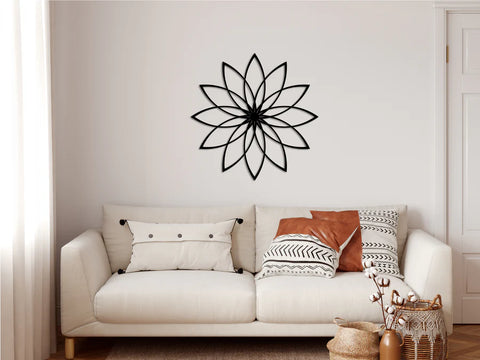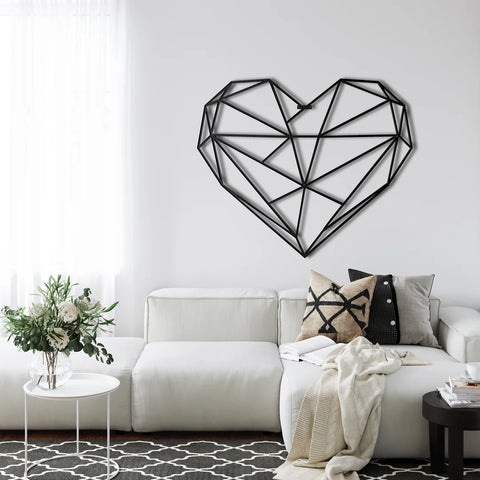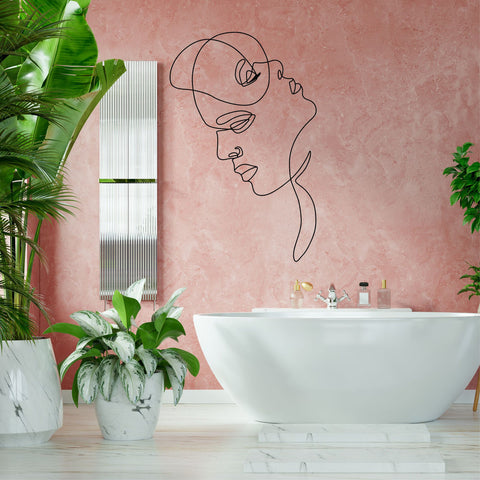Wall art, an essential element in the realm of interior design, transcends mere decoration to enrich our living spaces in a multitude of profound ways. As we delve into the myriad roles wall art plays, it becomes evident that its impact is both vast and nuanced, shaping environments, invoking emotions, and expressing identity. Dekadron, known for its unique metal wall art and decor pieces, adds a distinctive touch to the array of wall art options available.
Geometric Flower Metal Wall Art
Related: Metal Wall Art: The Ultimate Guide to Buying and Decorating
Aesthetic Appeal
The primary, most apparent use of wall art is to enhance the aesthetic appeal of a space. Wall art serves as a focal point, adding color, texture, and dimension to rooms. It can transform bland walls into captivating displays, making spaces feel more polished and intentionally designed. Art pieces can be selected to complement the interior design scheme, adding harmony or contrast to elevate the overall look of a room.
Emotional Influence
Wall art holds the power to evoke emotions, making spaces feel more inviting and alive. The choice of art can reflect a range of moods, from tranquility and serenity to excitement and vibrancy. Artwork can thus create an ambiance, influencing how people feel within a space. It's not merely about the visual appeal but about connecting on an emotional level, making spaces more personal and meaningful.
Expression of Personality and Identity
Homes and workspaces are personal sanctuaries and extensions of our identities. Wall art offers a unique way to express individuality, interests, and tastes. Whether it's a bold, abstract painting, a serene landscape, or a vibrant street art piece, each selection tells a story, revealing aspects of the owner's personality. Art becomes a language through which people communicate their values, beliefs, and passions.
Cultural Representation and Appreciation
Art is a reflection of culture, encapsulating history, traditions, and societal values. Through wall art, individuals can showcase cultural heritage and appreciation, creating a space that honors diversity and encourages cultural understanding. Art from different parts of the world can serve as a window into various cultures, fostering a global perspective and enriching our appreciation of humanity's artistic diversity.
Inspiration and Creativity
For many, wall art serves as a source of inspiration and creativity. Artworks can stimulate the imagination, provoke thought, and inspire new ideas. This is particularly significant in spaces dedicated to creativity and innovation, such as studios, offices, and classrooms. The presence of stimulating visual elements can enhance cognitive functions and foster an environment conducive to creative thinking.
Woman and Man Abstract Face Metal Wall Art
Educational Value
Wall art can also have an educational component, offering opportunities for learning and exploration. Artworks that depict historical events, scientific concepts, or geographic locales can serve as visual teaching tools, sparking curiosity and facilitating discussions. In both home and public spaces, art can engage viewers, inviting them to explore new subjects and deepen their understanding of the world.
Health and Wellbeing
The benefits of wall art extend to health and wellbeing, with studies suggesting that engaging with art can have therapeutic effects. Viewing art can reduce stress, promote relaxation, and improve overall mental health. In healthcare settings, art contributes to healing environments, aiding in patient recovery. Thus, the presence of art in living and working spaces can contribute to a sense of wellbeing and quality of life.
Economic Value
Beyond its aesthetic and emotional contributions, wall art can be an investment. Original artworks, limited edition prints, and pieces by emerging artists have the potential to appreciate in value over time. Collecting art can thus be both a personal passion and a strategic investment, contributing to the economic vibrancy of the art market and supporting artists and galleries.
Social Connection
Finally, wall art plays a role in fostering social connections. Art can serve as a conversation starter, bridging gaps between people with shared interests or diverse perspectives. In public spaces and galleries, art encourages community engagement, offering shared experiences that can unite people. The act of viewing and discussing art can build relationships, enhance empathy, and foster a sense of community.
In conclusion, the significance of wall art extends far beyond mere decoration. It enriches our spaces and lives in multifaceted ways, influencing emotions, expressing identity, fostering creativity, and promoting wellbeing. Wall art is a testament to the power of visual expression, playing a crucial role in shaping the character of our environments and enhancing our quality of life. Whether in homes, workplaces, or public spaces, wall art remains a vital component of human expression and connection.







Leave a comment